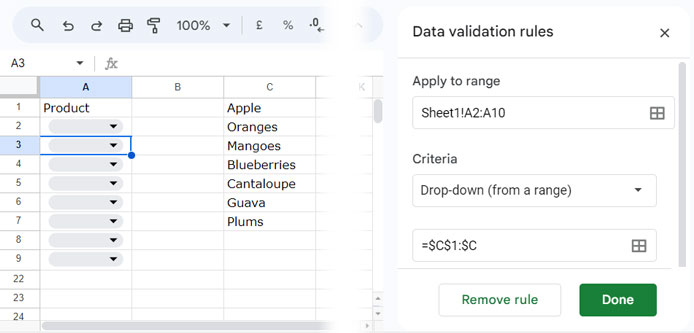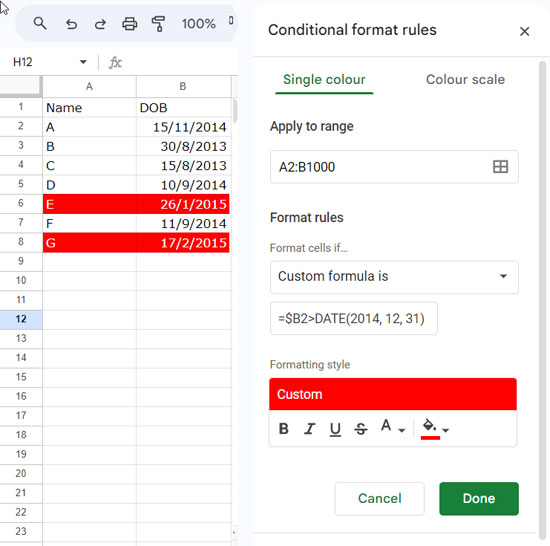To effectively manipulate data, it is crucial to ensure the accuracy and consistency of the data. In Google Sheets, there are various methods to prevent invalid data entry.
For example, some of the approaches to prevent invalid data entry in Google Sheets include using data validation, protecting sheets and ranges, using array formulas, leveraging conditional formatting, and integrating with Google Forms.
In this post, our primary focus will be on utilizing data validation to enhance data accuracy in Google Sheets, although we’ll also touch on other aspects.
As an example, you can prevent users from entering an invalid date by prompting them to use a date picker rather than manually inputting it.
You can adopt the following tips to restrict data entry in specific cells or ranges:
- Restrict users from entering dates in invalid format.
- Limit numbers with specified conditions, such as between, less than, greater than, or equal to.
- Allow text input exclusively.
- Facilitate entry of only predefined values by providing dropdown options.
Using Data Validation to Prevent Invalid Data Entry in Google Sheets
In this tutorial, we will explore the effectiveness of using Data Validation in Google Sheets to avoid invalid data entry.
Restrict to Specific Values
Often, data entries involve employee names, product names, product IDs, etc. Typos can occur even if you know the names, and new users in a collaborated sheet might not be familiar with all the entries.
To ensure accuracy and uniqueness, utilize a drop-down with available options. For instance, if entering product names in column A:
- Enter all product names in another column, like column C.
- Select the cells needing a drop-down, for example, A2:A10.
- Click on Insert > Drop-down.
- Under Criteria, select Drop-down (from a range).
- Enter C1:C in the field below.
- Click Done.

Restrict to Specific Data Type
Data validation can also enforce a specific data type, addressing issues like mixed data types in a column, which can affect functions like QUERY.
To ensure consistent data types, use the following validation rule, assuming product IDs may vary between numbers and alphanumeric characters:
- Select the range, for example, B2:B15.
- Click on Data > Data validation.
- Click Add Rule.
- Under criteria, select Custom formula is.
- Insert the formula:
=ISTEXT(B2). - Click on Advanced options.
- Select Show help text for the selected cell.
- In the field, enter the text “Enter text only. If you enter a number, start with ‘ to format the number as text.”
- Select Reject the input and click Done.

Now, users will be permitted to enter only text in B2:B15. If attempting to enter any other data type, such as a number, Sheets will display the provided help text.
To avoid incorrect date entries, replace ISTEXT with ISDATE, and for numbers, replace ISTEXT with ISNUMBER.
For more data validation examples, such as less than, greater than, equal to, and between, please refer to my tutorial titled The Best Data Validation Examples in Google Sheets.
Using Conditional Formatting to Prevent Invalid Data Entry in Google Sheets
Highlight rules serve as attention grabbers, especially when vibrant colors are chosen. Let’s explore how they can assist in preventing invalid data entries in Google Sheets.
For instance, consider an event organized in your school for students born on or before December 31, 2014. You are entering participating student names in A2:A and their dates of birth (DOBs) in B2:B.
The following highlight rule will emphasize rows containing a DOB greater than December 31, 2014:
= $B2 > DATE(2014, 12, 31) // date in the syntax DATE(year, month, day)To implement this rule, follow these steps:
- Select cells A2:B.
- Click on Format > Conditional formatting.
- Under Format rules, select Custom formula is.
- Enter the provided formula.
- Under Formatting style, choose Red fill color and white text color.
- Click Done.

Related: Date-Related Conditional Formatting Rules in Google Sheets.
The Role of Formulas in Preventing Invalid Data Entry in Google Sheets
If you’re wondering how formulas contribute to preventing invalid data entry and maintaining data integrity, Google Sheets offers several functions to check cell values. Here is a list of some key functions:
- ISNUMBER: Checks if a value is a number.
- ISNONTEXT: Verifies if a value is non-textual.
- ISBLANK: Identifies blank cells.
- ISTEXT: Determines if a value is text.
- DATEVALUE: Checks if a value is a date.
- ISURL: Validates if a value is a URL.
- ISEMAIL: Confirms if a value is an email address.
Note: If you want to learn these functions, you can check out my function guide.
For instance, to validate dates in column A, you can utilize the following formula in cell B1:
=ArrayFormula(DATEVALUE(A1:A))If an error is returned, it indicates that the cell value in the corresponding row is not a valid date.

Note: The other functions in the list will return TRUE or FALSE.
Fortifying Data Integrity in Google Sheets through Google Forms
One of the advantages of Google Forms is its seamless integration with Google Sheets.
Rather than sharing your Sheets directly, you can distribute a Google Forms form to gather data. Google Forms offers various question types, most of which support data validation.
Utilize question types like tickbox grid, date, and time, among others, to ensure valid entries in your Sheets.
If you’re new to Google Forms, you can explore my comprehensive guide covering all question types: How to Set Up Google Docs Forms: A Comprehensive Guide.
Conclusion
Throughout this guide, we’ve explored numerous examples demonstrating how to prevent invalid data entry in Google Sheets, covering some of the most crucial techniques.
In addition to the discussed methods, you can leverage other features like Data > Protect sheets and ranges, Data > Data clean-up, etc., to further fortify data integrity in Google Sheets.
Thank you for reading. Enjoy!






















I wish to allow a value entry only once from a list of values. This is to make sure that no two groups get the same value. How do i do it?
Hi Auram,
I think I’ve interpreted your question correctly. I’ll try to come back with a tutorial related to the same soon.
Thanks.
Hi Auram,
You may find this tutorial useful.
Distinct Values in Drop Down List in Google Sheets
The data validation… I see how to you use it in the spreadsheet, but when a form is connected there is no error message given to the user submitting the form